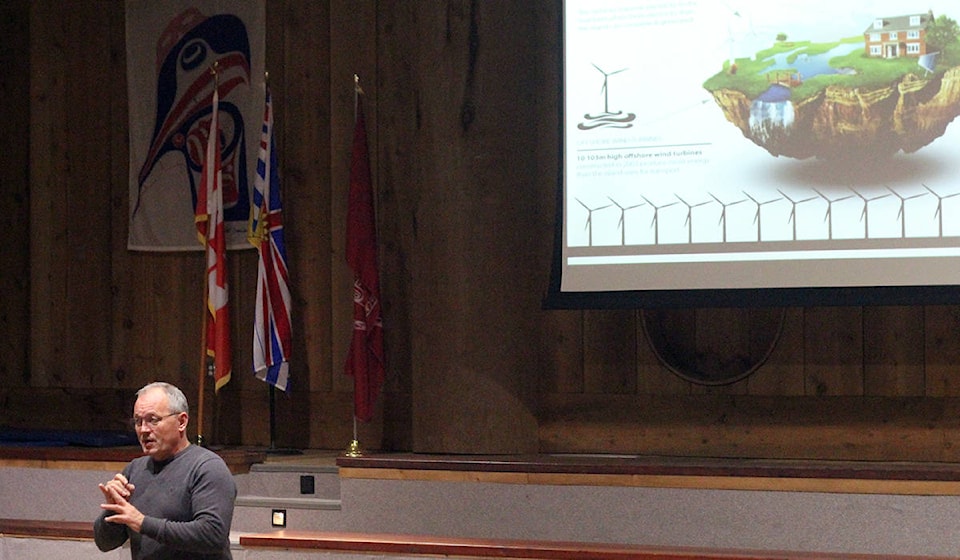The Danish island of Samsø doesn’t have even a single traffic light to match the one on Haida Gwaii.
But with just 3,700 people, Samsø leads the world for its switch to green energy, and it has made good money doing so.
“It was a bit of a job, because it was a conservative little community that didn’t really like change so much,” says Søren Hermansen, an islander who got hired 20 years ago to start organizing Samsø’s shift away from imported diesel and coal power.
“It’s probably much easier here, where you’re really much more ready for change.”
Hermansen and Thomas Winkler, the Danish ambassador to Canada, recently spoke at the Kay Centre in Skidegate last Saturday as part of an inter-island exchange with Haida Gwaii.
Related: Islands in the Rough — Making Haida Gwaii a role model for renewable energy
A few months ago, Gwaliga Hart and Jaalen Edenshaw flew to Samsø on behalf of the Haida Nation, to see how people there managed to finance and build enough renewable energy projects to make the island energy independent and carbon-neutral.
Since about 2008, Samsingers have produced more wind, biomass, and solar energy each year than they use from fossil fuels.
Winkler explained that overall, Denmark is a rich country — the average income is about $74,000. But unlike Canada, Denmark is not particularly rich in natural resources.
“We have a little oil and gas in the North Sea — nothing that will keep us going for very long,” Winkler said.
“So we’ve always been dependent on importing energy, until our government decided we must find another way of making our community not just work, but also grow.”
In 1998, following the Kyoto Protocol, Samsø competed with four other areas of Denmark to be chosen as the country’s renewable-energy role model. The target, which they hit, was to be carbon-neutral in 10 years.
But apart from funding his job, Hermansen said the win didn’t come with any special breaks or direct funding. The islanders had to come up with their own plan, and they had to invest their own money.
Like any part of Denmark, Samsø could access some generous government subsidies and 10-year power-price guarantees for renewable power projects. But the islanders had to match those with private investment and local co-operatives, and a lot relied on bank loans.
Hermansen said Samsø isn’t particularly rich, either.
“We are the poorest island in Denmark.”
In fact, the island’s farming and fishing economy has struggled for decades, and still does. Summer tourism has become the second-biggest business on island — the favourite spot is a protected coastal area.
Like Haida Gwaii, Samsø is not an easy place for young people to find work and the population is declining. Hermansen, who grew up on a family farm, had to go off-island to finish high school, and there have also been cuts to the local hospital service.
So to get community buy-in, Hermansen said people had to trust there was a solid business case behind the green-energy shift.
“It’s not a vision or a dream, it’s something really concrete,” he said, noting that it was important to move bit-by-bit, and to meet in person with small groups of people.
Hermansen said the islanders decided not to invest in any technology that was unlikely to pay for itself in 10 years.
Back in 1998, that meant going with wind turbines and district heating systems powered by locally grown hay — something local farmers liked.
Eventually, the islanders built 10 onshore and 11 offshore wind turbines, plus four biomass heating plants and some solar panels, including some that now charge a fleet of electric cars.
Unlike Haida Gwaii, Samsø is connected to the mainland power grid, and about 80,000 of the 105,000 megawatt-hours the island produces gets sold to the rest of Denmark.
Hermansen said it was that opportunity to make money, not just the environmental goal, that motivated people enough to build 70-metre wind turbines along Samsø’s scenic skyline.
“When they’re spinning, it sounds very good,” he said. “It sounds like money in your pocket, because all the money stays on the island.”
Hermansen said in the 1990s, Samsø’s choice of wind power made sense given the island’s windy location, and the costs at the time.
Haida Gwaii might decide on different technology, he said, but the much bigger challenge is simply to get everyone to agree on the plan.
On that score, Hermansen said there is a big advantage to being a small bunch of islanders.
“In cities it’s much easier just to be with friends who think the same and have the same political vision,” he said.
“On an island, we sit down and talk about this, no matter how different we are.”
andrew.hudson@haidagwaiiobserver.com
Like us on Facebook and follow us on Twitter
